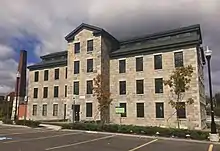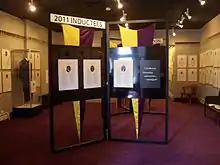National Women's Hall of Fame
The National Women's Hall of Fame is an American institution created in 1969 by a group of people in Seneca Falls, New York, the location of the 1848 women's rights convention.[1]


The National Women's Hall of Fame inducts distinguished American women through a rigorous national honors selection process involving representatives of the nation's important organizations and areas of expertise.[2] Nominees are selected on the basis of the changes they created that affect the social, economic or cultural aspects of society; the significant national or global impact and results of change due to their achievement; and the enduring value of their achievements or changes.[3] Induction ceremonies are held every odd- numbered year in the fall, with the names of the women to be honored announced earlier in the spring, usually during March, Women's History Month.[4][5]
Location
The National Women's Hall of Fame was hosted by Eisenhower College until 1979, when the organization rented out a historic bank building in the Seneca Falls Historic District. The historic bank was renovated to house the NWHF's permanent exhibit, historical artifacts, and offices.[6] In August 2020, the National Women's Hall of Fame opened its door to the third and final home: the historic Seneca Knitting Mill, which resides across the canal of the Women's Rights National Historical Park where 1848 Convention was held. The site is in view of the Wesleyan Chapel where the 1848 women's rights convention took place.[7] This renovation and move into the historic Seneca Knitting Mill has taken several years to accomplish. In 2014 the organization's board undertook a $20 million capital campaign to fund the development of the 1844 Seneca Knitting Mill, which is associated with the abolitionist movement and with the birthplace of women's rights.[7] The move and finalization of Phase 1 has currently doubled the size of the National Women's Hall of Fame. Currently, campaigning to work on Phase 2: a elevator, additional staircase, and other renovations is underway. Once the Homecoming Campaign is complete, the historic Seneca Knitting Mill will quadruple the available space to 16,000 square feet (1,500 m2), including exhibit space, offices, and meeting space for conferences, wedding receptions, and community events.[7]
Inductees
A–J
- Faye Glenn Abdellah
- Bella Abzug
- Abigail Adams
- Jane Addams
- Madeleine Albright
- Tenley Albright
- Louisa May Alcott
- Florence Ellinwood Allen
- Gloria Allred
- Linda Alvarado
- Dorothy H. Andersen
- Marian Anderson
- Ethel Percy Andrus
- Maya Angelou
- Susan B. Anthony
- Virginia Apgar
- Ella Baker
- Lucille Ball
- Ann Bancroft
- Clara Barton
- Eleanor K. Baum
- Ruth Fulton Benedict
- Mary McLeod Bethune
- Antoinette Blackwell
- Elizabeth Blackwell
- Emily Blackwell
- Amelia Bloomer
- Nellie Bly
- Louise Bourgeois
- Margaret Bourke-White
- Lydia Moss Bradley
- Myra Bradwell
- Mary Carson Breckinridge
- Nancy Brinker
- Gwendolyn Brooks
- Pearl S. Buck
- Betty Bumpers
- Charlotte Bunch
- St. Frances Xavier Cabrini
- Mary Steichen Calderone
- Annie Jump Cannon
- Rachel Carson
- Eleanor Rosalynn Smith Carter
- Mary Ann Shadd Cary
- Mary Cassatt
- Willa Cather
- Carrie Chapman Catt
- Julia Child
- Lydia Maria Child
- Shirley Chisholm
- Hillary Clinton
- Jacqueline Cochran
- Mildred Cohn
- Bessie Coleman
- Eileen Collins
- Ruth Colvin
- Rita Rossi Colwell
- Joan Ganz Cooney
- Mother Marianne Cope
- Gerty Theresa Radnitz Cori
- Jane Cunningham Croly
- Matilda Cuomo
- Angela Davis
- Paulina Kellogg Wright Davis
- Dorothy Day
- Marian de Forest
- Donna de Varona
- Karen DeCrow
- Sarah Deer
- Emma Smith DeVoe
- Emily Dickinson
- Dorothea Dix
- Elizabeth Hanford Dole
- Marjory Stoneman Douglas
- St. Katharine Drexel
- Anne Dallas Dudley
- Mary Barret Dyer
- Kathleen Eagan
- Amelia Earhart
- Sylvia A. Earle
- Catherine Shipe East
- Crystal Eastman
- Mary Baker Eddy
- Marian Wright Edelman
- Gertrude Ederle
- Gertrude Belle Elion
- Dorothy Harrison Eustis
- Alice C. Evans
- Geraldine Ferraro
- Ella Fitzgerald
- Jane Fonda
- Betty Ford
- Aretha Franklin
- Helen Murray Free
- Betty Friedan
- Margaret Fuller
- Matilda Joslyn Gage
- Ina May Gaskin
- Althea Gibson
- Lillian Moller Gilbreth
- Charlotte Perkins Gilman
- Ruth Bader Ginsburg
- Maria Goeppert Mayer
- Katharine Graham
- Martha Graham
- Temple Grandin
- Linda Grant DePauw
- Ella T. Grasso
- Marcia Greenberger
- Martha Wright Griffiths
- Sarah Grimké
- Angelina Emily Grimke Weld
- Mary Hallaren
- Fannie Lou Hamer
- Alice Hamilton
- Lorraine Hansberry
- Martha Matilda Harper
- Patricia Roberts Harris
- Helen Hayes
- Dorothy Height
- Beatrice Hicks
- Barbara Hillary
- Oveta Culp Hobby
- Barbara Holdridge
- Billie Holiday
- Wilhelmina Cole Holladay
- Jeanne Holm
- Bertha Holt
- Grace Murray Hopper
- Julia Ward Howe
- Dolores Huerta
- Helen LaKelly Hunt
- Swanee Hunt
- Zora Neale Hurston
- Anne Hutchinson
- Barbara Iglewski
- Shirley Ann Jackson
- Victoria Jackson
- Mary Jacobi
- Frances Wisebart Jacobs
- Mae Jemison
- Barbara Rose Johns
- Mary Harris Jones
- Barbara Jordan
K–Z
- Helen Keller
- Leontine T. Kelly
- Susan Kelly-Dreiss
- Frances Oldham Kelsey
- Nannerl Keohane
- Jean Kilbourne
- Billie Jean King
- Coretta Scott King
- Julie Krone
- Elisabeth Kübler-Ross
- Maggie Kuhn
- Stephanie L. Kwolek
- Henrietta Lacks
- Susette La Flesche
- Winona LaDuke
- Carlotta Walls LaNier
- Dorothea Lange
- Sherry Lansing
- Allie B. Latimer
- Emma Lazarus
- Lilly Ledbetter
- Mildred Robbins Leet
- Maya Lin
- Anne Morrow Lindbergh
- Patricia Locke
- Belva Lockwood
- Juliette Gordon Low
- Clare Boothe Luce
- Shannon W. Lucid
- Mary Lyon
- Mary Mahoney
- Nicole Malachowski
- Wilma Mankiller
- Philippa Marrack
- Barbara McClintock
- Katharine Dexter McCormick
- Louise McManus
- Margaret Mead
- Barbara Mikulski
- Kate Millett
- Patsy Takemoto Mink
- Maria Mitchell
- Toni Morrison
- Constance Baker Motley
- Lucretia Mott
- Kate Mullany
- Aimee Mullins
- Carol Mutter
- Antonia Novello
- Sandra Day O'Connor
- Georgia O'Keeffe
- Rose O'Neill
- Annie Oakley
- Rosa Parks
- Ruth Patrick
- Alice Paul
- Nancy Pelosi
- Mary Engle Pennington
- Frances Perkins
- Rebecca Talbot Perkins
- Esther Peterson
- Judith L. Pipher
- Jeannette Rankin
- Janet Reno
- Ellen Swallow Richards
- Linda Richards
- Sally Ride
- Rozanne L. Ridgway
- Edith Nourse Rogers
- Mary Joseph Rogers
- Eleanor Roosevelt
- Ernestine Louise Potowski Rose
- Sister Elaine Roulet
- Janet Rowley
- Wilma Rudolph
- Josephine St. Pierre Ruffin
- Mary Harriman Rumsey
- Florence Sabin
- Sacagawea
- Bernice Sandler
- Margaret Sanger
- Katherine Siva Saubel
- Betty Bone Schiess
- Patricia Schroeder
- Anna Schwartz
- Felice N. Schwartz
- Blanche Stuart Scott
- Florence B. Seibert
- Elizabeth Bayley Seton
- Donna Shalala
- Anna Howard Shaw
- Catherine Filene Shouse
- Eunice Mary Kennedy Shriver
- Muriel Siebert
- Beverly Sills
- Louise Slaughter
- Eleanor Smeal
- Bessie Smith
- Margaret Chase Smith
- Sophia Smith
- Hannah Greenebaum Solomon
- Susan Solomon
- Sonia Sotomayor
- Laurie Spiegel
- Elizabeth Cady Stanton
- Gloria Steinem
- Helen Stephens
- Nettie Stevens
- Lucy Stone
- Kate Stoneman
- Harriet Beecher Stowe
- Harriet Williams Russell Strong
- Anne Sullivan
- Kathrine Switzer
- Henrietta Szold
- Mary Burnett Talbert
- Maria Tallchief
- Ida Tarbell
- Helen Brooke Taussig
- Mary Church Terrell
- Sojourner Truth
- Harriet Tubman
- Wilma Vaught
- Diane von Furstenberg
- Florence Schorske Wald
- Lillian Wald
- Madam C. J. Walker
- Mary Edwards Walker
- Emily Howell Warner
- Mercy Otis Warren
- Alice Waters
- Faye Wattleton
- Annie Dodge Wauneka
- Ida Wells-Barnett
- Eudora Welty
- Edith Wharton
- Sheila E. Widnall
- Emma Willard
- Frances Willard
- Oprah Winfrey
- Sarah Winnemucca
- Victoria Woodhull
- Flossie Wong-Staal
- Fanny Wright
- Martha Coffin Pelham Wright
- Chien-Shiung Wu
- Rosalyn Yalow
- Gloria Yerkovich
- Mildred "Babe" Didrikson Zaharias
References
- "Our History - National Women's Hall of Fame". National Women's Hall of Fame. Retrieved 2018-01-22.
- "FAQs - National Women's Hall of Fame". National Women’s Hall of Fame. Retrieved 2018-01-22.
- "18 Nominees Chosen for National Women's Hall of Fame". Christian Science Monitor. 1995-09-15. ISSN 0882-7729. Retrieved 2018-01-22.
- "2017 Induction Weekend - National Women's Hall of Fame". National Women’s Hall of Fame. Retrieved 2018-01-22.
- "Now Streaming Live: The National Women's Hall of Fame Inducts Victoria Jackson - Mother, Entrepreneur, Innovator, Author, and Philanthropist". The Guthy-Jackson Charitable Foundation. Archived from the original on 2018-01-22. Retrieved 2018-01-22.
- Buchanan, Paul D. (2009). The American Women's Rights Movement: A Chronology of Events and of Opportunities from 1600 to 2008. Branden Books. ISBN 9780828321600.
- Shaw, David L. (4 May 2015). "A Conversation With: Jill Tietjen, CEO of National Women's Hall of Fame". Finger Lakes Times. Retrieved 3 June 2018.
External links
| Wikimedia Commons has media related to National Women's Hall of Fame. |